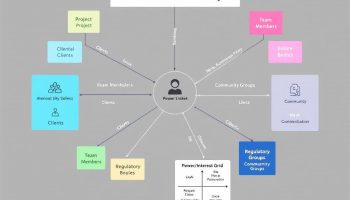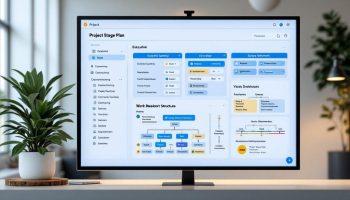
Stakeholder engagement approach examples offer essential frameworks for effective communication with key individuals or groups affecting or affected by your business activities. The six strategies—strategic stakeholder mapping, tailored communication channels, transparent project dashboards, structured feedback loops, digital collaboration platforms, and engagement metrics—create a comprehensive system for maintaining productive relationships with all stakeholders throughout project lifecycles.
Why Effective Stakeholder Engagement Matters
Stakeholder engagement approach examples provide your organization with structured methods to handle complex business relationships that directly impact project success and organizational reputation. When implemented effectively, these strategies minimize resistance to change, speed up decision-making processes, and reduce project risks. In today’s connected business environment, organizations with strong stakeholder engagement skills gain competitive advantages through improved innovation, stronger partnerships, and better brand perception. The six strategies outlined serve as practical tools for transforming stakeholder relationships from potential obstacles into valuable strategic assets.
Effective stakeholder engagement can lead to a 20% increase in overall project success rates, as it fosters collaboration and transparency throughout the project lifecycle.
Proven Stakeholder Engagement Approach Examples: Discover Six Effective Strategies
In today’s dynamic project environments, effective stakeholder engagement is crucial for success. This section presents six practical stakeholder engagement approach examples designed to enhance collaboration and ensure that stakeholder voices are heard. Each example highlights a specific strategy, providing insights into implementation and best practices. From strategic mapping and tailored communication channels to transparent dashboards and structured feedback loops, these strategies are geared toward fostering meaningful engagement. By understanding and applying these approaches, organizations can build stronger relationships with their stakeholders, improve project outcomes, and create a culture of inclusivity and accountability. Dive into each example to explore the details and learn how to enhance your stakeholder engagement efforts today.
1. Strategic Stakeholder Mapping
Developing an effective stakeholder engagement approach begins with comprehensive stakeholder mapping. This critical first step helps you identify who will impact or be impacted by your project. Create detailed influence/interest matrices to visualize each stakeholder’s position and importance to your initiative. When implementing a stakeholder engagement approach, document key concerns and priorities for each group to ensure their needs are addressed throughout the project lifecycle.
Your mapping should identify potential conflicts and alignments between stakeholders, allowing you to improve project collaboration and preemptively resolve issues. Remember to establish a system for regular updates to your stakeholder map as project dynamics change and new stakeholders emerge. Consider these elements for your mapping process:
- Categorize stakeholders by influence level and interest
- Note decision-making authority and reporting relationships
- Track communication preferences and frequency needs
- Document historical engagement patterns and past concerns
2. Tailored Communication Channels
Implementing an effective stakeholder engagement approach example begins with choosing the right communication channels. Your stakeholder engagement strategy should align with how different groups prefer to receive information. Some executives may prefer concise email updates, while technical teams might benefit from detailed documentation platforms.
Developing a multi-channel engagement strategy ensures your message reaches stakeholders through their preferred mediums. Consider these implementation options:
- Formal reports and presentations for executive stakeholders
- Collaborative platforms for team members requiring detailed information
- Regular video conferences for remote stakeholders
- Social media and newsletters for external stakeholders
Schedule consistent touchpoints based on project communication needs and stakeholder availability. By monitoring engagement metrics across different channels, you can refine your approach to maximize participation.
Adapting your communication style to match stakeholder preferences demonstrates respect for their time while increasing the likelihood they’ll engage meaningfully with your content. The key is flexibility in your approach while maintaining consistency in your core messaging.
Expert Insight: Choose communication channels that align with stakeholder preferences to enhance engagement. Use formal reports for executives, collaborative tools for teams, and video calls for remote participants. By monitoring metrics and adapting your approach, you show respect for their time and encourage meaningful interaction with your content.
3. Transparent Project Dashboards
Implementing a stakeholder engagement approach example that includes transparent dashboards dramatically improves project visibility. Your stakeholders need real-time access to project status information to feel genuinely engaged in the process. These dashboards provide clear visualization of progress metrics that transform complex data into easily digestible information.
By offering regular updates on key performance indicators through strategic dashboards, you create an environment of trust and accountability. Consider including these essential elements in your project dashboards:
- Progress bars showing completion percentages for major milestones
- Color-coded status indicators highlighting areas needing attention
- Timeline visualizations showing past performance and future projections
- Resource allocation summaries
Accessible feedback mechanisms integrated directly into the dashboard allow stakeholders to provide input without switching platforms. This streamlined approach to project communication encourages more frequent and meaningful interactions with your stakeholders, ultimately leading to better project outcomes.
Expert Insight: Create transparent project dashboards to enhance stakeholder engagement and trust. Include progress bars, color-coded status indicators, and timeline visualizations to present complex data clearly. Integrate feedback mechanisms for seamless communication, fostering meaningful interactions and ultimately driving improved project outcomes.
4. Structured Feedback Loops for Stakeholder Engagement
Implementing structured feedback loops is a crucial stakeholder engagement approach example that creates a continuous improvement cycle. Your stakeholder engagement strategy benefits significantly from establishing regular channels for input and response. Many organizations implement quarterly surveys alongside monthly feedback sessions to capture both quantitative and qualitative insights from key stakeholders.
When designing your feedback system, consider these essential components:
- Digital survey tools with both rating scales and open-ended questions
- Dedicated feedback sessions with rotating stakeholder representatives
- Anonymous submission options for sensitive concerns
- Structured follow-up protocols for addressing raised issues
Document all feedback received and create trackable action logs that assign responsibilities for implementing changes. The most effective feedback loops close the communication circle by informing stakeholders about how their input has influenced decisions or processes. This transparent approach builds trust and demonstrates your commitment to genuine engagement rather than performative listening.
Expert Insight: Establish structured feedback loops to enhance stakeholder engagement by using digital surveys, dedicated sessions, and anonymous input options. Document feedback and create action logs to assign responsibilities for changes. Close the communication loop by informing stakeholders how their input impacts decisions, fostering trust and authenticity.
5. Digital Collaboration Platforms for Enhanced Stakeholder Engagement
Implementing an effective stakeholder engagement approach involves utilizing digital platforms that connect all participants. These platforms offer centralized document sharing with version control to ensure everyone accesses the most current information. Your stakeholders can collaborate seamlessly through interactive discussion forums where ideas and concerns are openly addressed.
Virtual meeting capabilities enable real-time communication regardless of geographical location, making your stakeholder engagement more inclusive and responsive. These platforms support project collaboration by eliminating barriers to participation.
Most digital solutions now provide mobile accessibility for remote stakeholders, ensuring engagement continues even when team members are on the move. This feature is particularly valuable for:
- Executive stakeholders who travel frequently
- Field teams implementing project components
- International partners in different time zones
- Consultants working across multiple client sites
Your digital platform selection should align with specific stakeholder satisfaction needs while maintaining security and ease of use.
Expert Insight: Leverage digital collaboration platforms to enhance stakeholder engagement by ensuring seamless communication and document accessibility. Prioritize tools that enable real-time discussions and mobile access to accommodate stakeholders regardless of location. Align platform features with stakeholders’ specific needs for improved satisfaction and effective participation.
6. Engagement Metrics and Performance Framework
A comprehensive stakeholder engagement approach example must include a robust performance measurement framework to evaluate effectiveness. You need clear metrics to understand if your engagement efforts are yielding results. Start by defining measurable engagement metrics that align with your project objectives and stakeholder expectations.
Consider tracking these key performance indicators:
- Stakeholder satisfaction scores (via periodic surveys)
- Response rates to communications
- Meeting attendance and participation levels
- Issue resolution timeframes
- Implementation rate of stakeholder feedback
Regular reporting is essential for demonstrating engagement effectiveness to leadership. Create monthly or quarterly dashboards that visualize trends in stakeholder sentiment and participation. This approach allows you to improve stakeholder satisfaction while providing quantifiable evidence of your engagement strategy’s success.
For ongoing improvement, conduct periodic reviews of your measurement framework, adjusting metrics as project phases evolve or stakeholder priorities shift.

Stakeholder engagement approach examples like strategic mapping, tailored communication channels, and transparent dashboards form the foundation of effective project communication. These six strategies—completed by structured feedback loops, digital collaboration platforms, and engagement metrics—provide a comprehensive framework for connecting with and responding to stakeholder needs throughout the project lifecycle.
A robust stakeholder engagement approach example is essential for business success as it directly impacts project outcomes, risk management, and organizational reputation. By implementing these six communication strategies, enterprises can reduce resistance to change, accelerate decision-making processes, and build lasting relationships with key stakeholders that translate into measurable business value and competitive advantage.
Conclusion
Strategic stakeholder engagement requires a structured approach encompassing mapping, tailored communication, transparent dashboards, feedback mechanisms, digital collaboration, and performance measurement. These strategies collectively create an environment of trust, accountability, and continuous improvement that enhances project outcomes and builds lasting stakeholder relationships.
Actionable Steps
- Create detailed stakeholder influence/interest matrices to identify priorities and communication needs
- Develop a multi-channel communication strategy tailored to different stakeholder preferences
- Implement transparent project dashboards with visual progress metrics and feedback mechanisms
- Establish structured feedback loops with both surveys and dedicated discussion sessions
- Define measurable engagement metrics aligned with project objectives to track effectiveness






